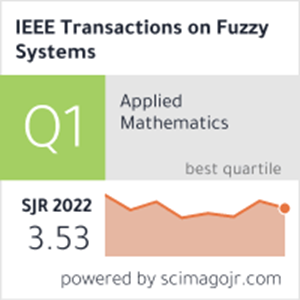具有模糊隶属关系的超图社区检测
IF 11.9
1区 计算机科学
Q1 COMPUTER SCIENCE, ARTIFICIAL INTELLIGENCE
引用次数: 0
摘要
超图社区检测揭示了现实超图的中尺度结构和功能特征。尽管从不同的角度开发了许多方法,但据我们所知,没有一种方法可以提供细粒度的超图模糊社区信息,并且识别出的清晰分区的质量通常是有限的。本研究定义了一组新的多尺度超图模糊隶属度概念,系统地量化了区间[0,1]内节点、超边和超图群体之间的部分隶属度(即隶属度等级),从而揭示了多尺度部分拓扑隶属关系。在此基础上,利用多尺度超图模糊隶属关系建立了一个通用框架——模糊隶属关系辅助超图模块化优化(FMHMO),以逼近模块化最优的清晰超图划分。FMHMO框架包括两个关键策略:基于超边缘相似性的超图约简(HS-HR)和基于模糊隶属度的超图分区恢复(FM-HPR)。特别是,HS-HR将超图简化为简单的加权图,将超边映射为节点,并使用新的超边相似度作为权重将它们的相互作用映射为边。因此,保留了原始超图的超边缘内拓扑和超边缘间拓扑。FM-HPR通过量化连接多个事件超边的桥节点的模糊隶属关系,从近似模性最优加权图划分中恢复超图划分,从而能够精确分配其清晰的超图社区隶属关系。合成数据集和真实数据集的实验结果表明,FMHMO在准确性和模块化质量方面优于最先进的超图社区检测算法。本文章由计算机程序翻译,如有差异,请以英文原文为准。
Hypergraph Community Detection With Fuzzy Memberships
Hypergraph community detection reveals both mesoscale structures and functional characteristics of real-life hypergraphs. Although many methods have been developed from diverse perspectives, to our knowledge, none can provide fine-grained hypergraph fuzzy community information, and the quality of identified crisp partitions is often limited. This study defines a set of novel concepts of multi-scale hypergraph fuzzy memberships that systematically quantify the partial belongingness (i.e., membership grades) among nodes, hyperedges, and hypergraph communities within the interval [0,1], thereby revealing the multi-scale partial topological affiliations. Furthermore, the multiscale hypergraph fuzzy memberships are employed to develop a general framework, named fuzzy membership-assisted hypergraph modularity optimization (FMHMO), aiming to approximate the modularity-optimal crisp hypergraph partition. The FMHMO framework comprises two key strategies: Hyperedge similarity-based hypergraph reduction (HS-HR) and fuzzy membership-based hypergraph partition recovery (FM-HPR). In particular, HS-HR reduces a hypergraph to a simple weighted graph, mapping hyperedges as nodes and their interactions as edges using novel hyperedge similarity as weights. Thereby, preserving intrahyperedge and interhyperedge topologies of the original hypergraph. FM-HPR recovers a hypergraph partition from the approximately modularity-optimal weighted graph partition by quantifying the fuzzy memberships of bridge nodes connecting multiple incident hyperedges, thereby enabling precise assignment of their crisp hypergraph community affiliations. Experimental results in both synthetic and real-world datasets indicate the superiority of FMHMO over state-of-the-art hypergraph community detection algorithms in accuracy and modularity quality.
求助全文
通过发布文献求助,成功后即可免费获取论文全文。
去求助
来源期刊

IEEE Transactions on Fuzzy Systems
工程技术-工程:电子与电气
CiteScore
20.50
自引率
13.40%
发文量
517
审稿时长
3.0 months
期刊介绍:
The IEEE Transactions on Fuzzy Systems is a scholarly journal that focuses on the theory, design, and application of fuzzy systems. It aims to publish high-quality technical papers that contribute significant technical knowledge and exploratory developments in the field of fuzzy systems. The journal particularly emphasizes engineering systems and scientific applications. In addition to research articles, the Transactions also includes a letters section featuring current information, comments, and rebuttals related to published papers.
 求助内容:
求助内容: 应助结果提醒方式:
应助结果提醒方式:


